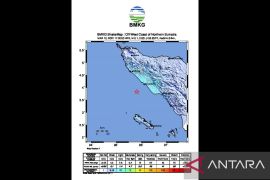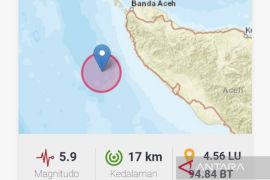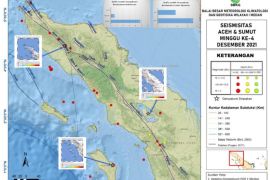"Data on damage to structures and the number of victims may still rise, given the massive destruction," the spokesman of the National Disaster Mitigation Agency (BNPB), Sutopo Purwo Nugroho, said at a press conference here on Wednesday.
He noted that as of 1:10 p.m., 52 people had been found dead, 73 seriously injured, and 200 lightly wounded in addition to some 10,000 who had been affected by the disaster.
"The victims include both children and adults," he declared.
He clarified that 50 people had been killed in the district of Pidie Jaya, where 70 were seriously injured and 122 lightly wounded.
Two deaths were found in the district of Bireuen, where three others had been seriously injured and 78 lightly wounded, while 10,000 Islamic boarding school students had been affected.
Due to the disaster, 105 shop houses had collapsed and 123 houses and 14 mosques were heavily damaged or had collapsed. The Pidie Jaya regional hospital was heavily damaged, and one school building had collapsed, while cracks were found on several streets, he added.
In Bireun, two houses had collapsed, one mosque was heavily damaged, a university campus building had collapsed, and 35 houses were heavily damaged.
Sutopo said the epicenter of the quake, which occurred at 5.03 a.m., was on land in Pidie Jaya.
The tremor was felt by the people in the district for 15 seconds, for five seconds in Banda Aceh, 10 seconds in Aceh Besar, and 10 seconds in Bireun.
"Light aftershocks have occurred 12 times, which is normal, as the tectonic system is attempting to create a new balance," he stated.
He explained that earthquake tremors from an on-land epicenter result in much more significant damage to residential areas than usual.
"The intensity reached 6 to 7 on the Modified Mercally Intensity Scale, so buildings without a quake-proof design collapsed," he said.
The epicenter of the quake originated on the active Samalanga-Sipopok fault line, though the movement was not as fast as it is when earthquakes occur at sea. The line moves from southwest to northeast, he added.
Sutopo admitted that he could not yet confirm whether the quake would trigger the movement of other active fault lines.
"This is still being studied by the Meteorology, Geophysics, and Climatology Agency," he said. (*)
Editor: Heru Purwanto
Copyright © ANTARA 2016











